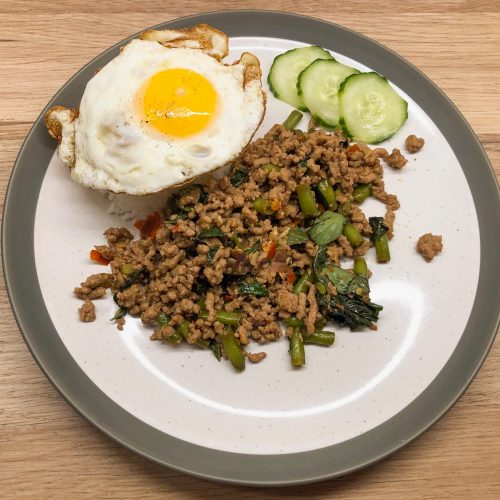This chilli & Thai basil pork recipe is spicy and satisfying. Plus, it comes together in just a few minutes, making it perfect for a midweek dinner!
Chilli & Thai basil pork ís a dish that hits hard, packed full of powerful endorphin inducing garlic and chillies. The bold flavours combine perfectly with fragrant jasmine rice. With a Thai style crispy egg, this is feel good food for sure.
In the UK you can find Chilli & Thai basil at Thaikhun. A variation on pad kra pao (stir-fried holy basil), it’s essentially the same dish made using Thai basil instead. Thai basil has a distinct aniseed flavour and is easier to find in the West compared to Holy basil, so you’ll oddly often find it used in ‘kra pao’ dishes, despite kra pao literally meaning Holy basil. If all you have is European basil (the kind you’d put on pizza), you can use that instead. It’ll taste slightly different (and, actually, a little closer to authentic pad kra pao made with Holy basil).
Phew, with all the basil varieties out of the way, let’s get cooking!
Ingredients For Chilli & Thai Basil Pork
Chilli & Thai Basil Pork is made using all of the ingredients you’d find in a traditional Thai pad kra pao dish, with Thai basil used in place of Holy basil.
- Red Thai / Birdseye Chillies
- Shallots
- Garlic
- Oyster Sauce
- Thin Soy Sauce
- Dark Soy Sauce
- Fish Sauce
- Sugar
- Vegetable Oil
- Pork Mince
- Green Beans
- Light Stock or Water
- Holy Basil (see notes)
How To Make Chilli & Thai Basil Pork
This chilli & Thai basil pork is one of the easiest stir fry dishes to prepare and cook. The ingredients are simple, so preparation time is minimal. First, hot chillies, shallots and garlic are pounded in a pestle and mortar. Next, the sauce ingredients are mixed in a bowl and set aside ready for use. Next, the ingredients are stir fried together with pork mince and aromatic basil leaves.
1: Prepare The Ingredients
In a pestle and mortar, pound the hot chillies, shallot and garlic to form a paste. In a small bowl, add the oyster sauce, thin soy sauce, dark soy sauce, fish sauce and sugar. Mix well and set aside.
2: Cook Chilli & Thai Basil Pork
Heat a wok or frying pan over a medium-high heat. Add the vegetable oil and the pork mince and stir-fry for 1 minute until the pork begins to brown. Add the prepared paste and the green beans and stir-fry for another 30-40 seconds. Add the prepared sauce and stock or water, mix well and simmer for 1 minute or until the sauce reduces slightly. Switch off the heat, add the fresh basil leaves and mix well once more.
3: Serve Chilli & Thai Basil Pork
Arrange jasmine rice on a serving plate. Pour the sizzling chilli & Thai basil pork around the rice. Top with a crispy fried egg and serve.
I hope you’ll try this chilli & Thai basil pork recipe. If you do, let me know in the comments how it went!
Chilli & Thai Basil Pork
Ingredients
- 2-3 Thai / birdseye chillies
- 1 small shallot
- 3 cloves garlic
- 1 teaspoon oyster sauce
- 1 teaspoon thin soy sauce
- Dash dark soy sauce
- Dash fish sauce
- 1/2 teaspoon sugar
- 1 tablespoon oil
- 100g pork mince
- 1 small handful green beans, sliced
- 75 ml light chicken stock or water
- 1 handful Thai basil
Instructions
- In a pestle and mortar, pound the hot chillies, shallot and garlic to form a paste.
- In a bowl, add oyster sauce, thin soy sauce, dark soy sauce, fish sauce & sugar. Mix well and set aside.
- Heat a wok or frying pan over a medium-high heat. Add the vegetable oil and the pork mince and stir-fry for 1 minute until the pork begins to brown. Add the prepared paste and the green beans and stir-fry for another 30-40 seconds. Add the prepared sauce and stock or water, mix well and simmer for 1 minute or until the sauce reduces slightly. Switch off the heat, add the fresh basil leaves and mix well once more.
- Arrange jasmine rice on a serving plate. Pour the sizzling chilli & Thai basil pork around the rice. Top with a crispy fried egg and serve.
Do you like this Thai takeaway style Chilli & Thai Basil Pork recipe? If so, buying a copy of my book might appeal to you! In The Thai Street Food Secret you can find a host of Thai takeaway and restaurant style recipes that you can make at home. You’ll learn how to make chicken satay skewers, drunken noodles, crispy volcano chicken, mango sticky rice and more! You can buy The Thai Takeaway Secret in paperback or kindle form here.
- Make your favourite Thai takeaway dishes at home!As a nation we spend £10 billion each year on takeaways
- But ‘fakeaway’ dishes are proving increasingly popular for a fraction of the cost
- The Thai Takeaway Secret offers a wide selection of popular recipes that will ensure your homemade dishes look and taste exactly like those offered by your favourite Thai restaurants and street food spots
- Make side dishes and snacks from Tamarind Tofu and Lemongrass Chilli Chicken Wings to Prawn Tempura and Sweetcorn Fritters, and with stir fry and curry dishes for every palette including Pad King Moo, Caramel Pork, Massaman Curry, Panang Curry, and Tamarind Chicken
- There are delicious chef’s specials and noodle and recipe recipes too – including Pad Thai, Crispy Volcano Chicken, Thai Style Crispy Fried Egg, Coconut Rice, and Fried Garlic Noodles



